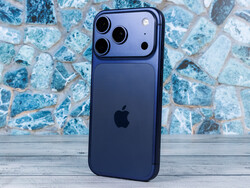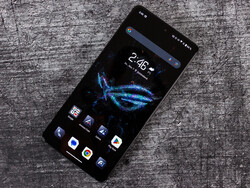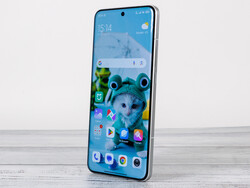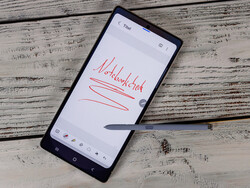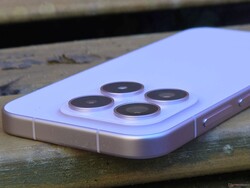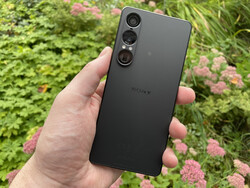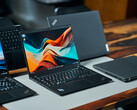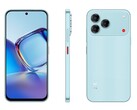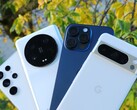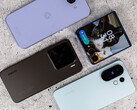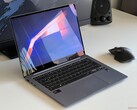
Ranking: Best smartphones reviewed by Notebookcheck
November 2025 update.
Smartphones are essential for our everyday lives. Notebookcheck tests numerous Android phones and iPhones each month, evaluating performance, features, and overall value, and this list highlights the best smartphones reviewed recently.Daniel Schmidt (translated by DeepL) Published 🇩🇪 🇹🇷 ...
With ever more powerful processors and graphics chips, high-quality cameras and increasing screen sizes, smartphones can perform a variety of daily tasks. Traditional communication is increasingly taking a back seat for high-end phones; what is needed is maximum performance for gaming, multitasking and AI, camera modules that make a conventional camera superfluous, vibrant displays and the longest battery life possible.
Competition at the top of the chart is fierce, with only a few percentage points separating certain models. This article lists the best phones tested by Notebookcheck over the past few months. For detailed information on the phones, we recommend reading the linked reviews.
The best smartphones, tested and ranked
Image | Model / Review | Price | Weight | Drive | Display | Screen / Body |
|---|---|---|---|---|---|---|
| Apple iPhone 17 Pro Apple A19 Pro ⎘ Apple A19 Pro 6-Core GPU ⎘ 12 GB Memory, 512 GB SSD | Amazon: 1. $36.00 Apple iPhone 17 Pro Silicone... 2. $7.64 Ailun 3 Pack Screen Protecto... 3. $44.00 Apple iPhone 17 Pro TechWove... List Price: 1549€ | 206 g | Apple 512GB NVMe | 6.30" 2622x1206 458 PPI OLED | 90 % | |
| Asus ROG Phone 9 Pro Qualcomm Snapdragon 8 Elite ⎘ Qualcomm Adreno 830 ⎘ 24 GB Memory, 1024 GB | Amazon: 1. $11.99 Ibywind Screen Protector for... 2. $7.99 beukei compatible for ASUS R... 3. $10.98 Guizzcg 2 Pack Screen Protec... List Price: 1499€ | 227 g | 1 TB UFS 4.0 Flash | 6.78" 2400x1080 388 PPI AMOLED | 88 % | |
| Xiaomi 15 Ultra Qualcomm Snapdragon 8 Elite ⎘ Qualcomm Adreno 830 ⎘ 16 GB Memory, 512 GB | Amazon: 1. $11.99 Ibywind for Xiaomi 15 Ultra ... 2. $9.29 Zeking [2 Pack for Xiaomi 15... 3. $19.99 Akcoo Screen Protector for X... List Price: 1499€ | 229 g | 512 GB UFS 4.1 Flash | 6.73" 3200x1440 521 PPI AMOLED | 90 % | |
| Samsung Galaxy S25 Ultra Qualcomm Snapdragon 8 Elite for Galaxy ⎘ Qualcomm Adreno 830 ⎘ 12 GB Memory, 256 GB | Amazon: 1. SAMSUNG Galaxy S25 Ultra, 25... 2. $908.00 SAMSUNG Galaxy S25 Ultra SM-... 3. $994.67 SAMSUNG Galaxy S25 Ultra ... List Price: 1449€ | 218 g | 256 GB UFS 4.0 Flash | 6.90" 3120x1440 498 PPI Dynamic AMOLED 2X | 93 % | |
| Xiaomi 17 Qualcomm Snapdragon 8 Elite Gen 5 ⎘ Qualcomm Adreno 840 ⎘ 12 GB Memory, 512 GB | Amazon: 1. $15.28 INIU for iPhone 17 Charger, ... 2. $26.69 INIU Mini Portable Charger, ... 3. $118.09 Xiaomi OpenWear Stereo Hi-Re... List Price: 650€ | 191 g | 512 GB UFS 4.1 Flash | 6.30" 2656x1220 464 PPI LTPO AMOLED | 89.5 % | |
| Honor Magic7 Pro Qualcomm Snapdragon 8 Elite ⎘ Qualcomm Adreno 830 ⎘ 12 GB Memory, 512 GB | Amazon: 1. $11.99 Ibywind for Honor Magic7 Pro... 2. $16.88 teroxa Honor Magic 7 Pro Cas... 3. $9.99 Anbzsign (2+2 Pack) for Hono... List Price: 1300€ | 223 g | 512 GB UFS 4.0 Flash | 6.80" 2800x1280 453 PPI OLED | 90 % | |
| Google Pixel 10 Pro Google Tensor G5 ⎘ IMG DXT-48-1536 ⎘ 16 GB Memory, 256 GB | Amazon: $849.00 List Price: 1199€ | 207 g | 256 GB UFS 4.0 Flash | 6.30" 2856x1280 497 PPI OLED | 87 % | |
| Samsung Galaxy S25 Qualcomm Snapdragon 8 Elite for Galaxy ⎘ Qualcomm Adreno 830 ⎘ 12 GB Memory, 256 GB | Amazon: 1. SAMSUNG Galaxy S25 Ultra, 25... 2. $908.00 SAMSUNG Galaxy S25 Ultra SM-... 3. $1,128.00 Samsung Galaxy S25 Ultra ... List Price: 899€ | 162 g | 256 GB UFS 4.0 Flash | 6.20" 2340x1080 416 PPI AMOLED | 91.1 % | |
| Sony Xperia 1 VII Qualcomm Snapdragon 8 Elite ⎘ Qualcomm Adreno 830 ⎘ 12 GB Memory, 256 GB | Amazon: 1. $11.99 Ibywind For Sony Xperia 1 VI... 2. $5.99 Supershieldz (2 Pack) Design... 3. $6.45 Anoowkoa 2 Pack for Sony Xpe... List Price: 1499€ | 197 g | 256 GB UFS 4.0 Flash | 6.50" 2340x1080 396 PPI OLED | 87 % | |
| Samsung Galaxy S25 Edge Qualcomm Snapdragon 8 Elite for Galaxy ⎘ Qualcomm Adreno 830 ⎘ 12 GB Memory, 256 GB | Amazon: 1. $11.99 firtstnow 3 Pack Glass Scree... 2. $6.79 Ailun Glass Screen Protector... 3. $7.99 amFilm Auto-Alignment OneTou... List Price: 1249€ | 163 g | 256 GB UFS 4.0 Flash | 6.70" 3120x1440 395 PPI Dynamic AMOLED 2X | 92 % |
Note: We transitioned to a new rating system in June 2024. In the new v8 rating, some ranking criteria were adapted to recent hardware developments, new criteria were introduced and certain measurement techniques were modified. As a result, v8 ratings are slightly lower than v7 ones and not directly comparable with previous versions. Further information on the new v8 rating can be found here.
Editorial comment
This month, the iPhone 17 Pro makes it to the top of the list. Also new is Xiaomi's 17 in its China flavor, which will eventually become available globally, too (probably in 2026). Whether this will also be the case for the Xiaomi 17 Pro and Pro Max is still uncertain, which is why we have decided to ignore them for the time being.
Other promising candidates are Vivo's X300 Pro, Oppo's Find X9 Pro as well as the OnePlus 15.
1st place - Apple iPhone 17 Pro
The iPhone 17 Pro is a predictable further development of the series, scoring points with numerous improvements such as the new, significantly brighter OLED display with better colors, a larger and more enduring battery, and the powerful A19 Pro chip with 12 GB of RAM ensuring outstanding system performance and one of the best battery runtimes for the product subcategory.
The iPhone 17 Pro is a powerful premium smartphone.
The main cameras have been improved, in particular the telephoto lens and the new 18-MP Center Stage front camera offer more flexibility and quality in everyday life. The updated design features a sturdy, albeit more scratch-sensitive aluminum frame, which underlines the slim look.
In terms of technology, the smartphone offers an extensive set of modern features including Wi-Fi 7, dual eSIM and USB 3.2. Nevertheless, there is some criticism: high-res audio via Bluetooth is missing and some new iOS 26 functions are not available in Europe.
If you want a larger display and even better battery life, and are not afraid of more weight, you should consider the iPhone 17 Pro Max instead.
2nd place - Asus ROG Phone 9 Pro
The ROG Phone 9 Pro is a high-end gaming smartphone that impresses with its enormous performance and special gaming features. Powered by the Snapdragon 8 Elite, it offers 24 GB of RAM and a 6.78-inch AMOLED display with 185 Hz, delivering a peak brightness of 2,500 cd/m².
Special features include the ROG GameCool 9 cooling solution along with the AeroActive Cooler X, which improve the gaming experience and prevent overheating. The product is robust, with Gorilla Glass Victus 2 and IP68 certification. There are additional physical buttons for gamers here as well as features such as AirTrigger and two USB-C ports.
Technically, Asus's ROG Phone 9 Pro is a top-notch product. However, corners were cut with regards to cameras and updates.
Its camera set is solid, with the Sony Lytia 700 sensor delivering usable results even in unfavorable lighting conditions. The 5,800-mAh battery supports fast wired and wireless charging. The phone consumes more energy than expected when gaming, and just two major Android updates are guaranteed.
3rd place - Xiaomi 15 Ultra
The 15 Ultra proved to be a powerful smartphone in our testing with a special focus on camera features. The product has a Leica quad rear camera, consisting of a 50-megapixel primary 1-inch sensor, a 50-megapixel ultra-wide-angle lens, a 50-megapixel telephoto lens with triple zoom and a 200-megapixel periscope telephoto lens with 4.3x zoom.
Xiaomi's 15 Ultra impresses with its powerful camera and wide range of functions, which should appeal to photography enthusiasts in particular.
The 6.73-inch LTPO AMOLED display offers a resolution of 3,200 x 1,440 pixels and a variable refresh rate of 1 Hz to 120 Hz. The smartphone is powered by the Qualcomm Snapdragon 8 Elite processor, supported by fast LPDDR5x RAM and UFS 4.1 storage. Its 6,000-mAh battery can be charged via USB-C at up to 90 watts, or wirelessly at up to 80 watts.
4th place - Samsung Galaxy S25 Ultra
The Galaxy S25 Ultra focuses on artificial intelligence (AI). Hardware improvements compared to the predecessor model are moderate at best. Cameras-wise, the phone offers a 50-megapixel ultra-wide-angle camera with the Samsung GN3 sensor, which is also used for macro shots. The main camera sensor has 200 megapixels, producing 12-megapixel photos through pixel binning. 3x and 5x optical zoom hardware is onboard. Image stabilization quality is remarkable, especially with the 5x zoom. Videos can be recorded in resolutions from 720p to 8K, with neat new features available, such as "Audio Eraser" to reduce background noise and "Nightography" for better recordings in low-light conditions.
Samsung's Galaxy S25 Ultra is a strong product that comes with 7 years of software updates.
The smartphone is powered by the Snapdragon 8 Elite for Galaxy processor, supported by 12 GB of RAM. Performance in benchmarks is excellent at first glance, but is reduced under continuous load to prevent overheating.
5th place - Xiaomi 17
While Xiaomi's 17 does set new standards for compact smartphones with its huge 7,000 mAh battery and powerful Snapdragon 8 Elite Gen 5, the phone is not without its weaknesses. The enormous battery capacity ensures runtimes that are well above those of most rival phones, but ups the weight and size noticeably which may turn fans of truly slim phones off.
The 17 shines with its gigantic battery, but is heavier as a consequence.
The new processor performs well, however, thermal management issues apparently prevent it, and its integrated graphics unit in particular, from revealing its full potential in longer load scenarios. Although the camera setup impresses with Leica optics and good low-light capabilities, the photos can sometimes appear oversaturated and over-sharpened in daylight. In addition, HyperOS 3 takes heavy inspitation from iOS, which may not appeal to every Android fan, and the Chinese version comes with limitations such as the lack of eSIM support and fewer years of guaranteed software support. Despite its strengths, the Xiaomi 17 therefore remains a compromise and is only availabile to buy from China-based sellers, such as TradingShenzhen.
6th place - Honor Magic7 Pro
The Magic7 Pro offers important bits of technology such as a fast USB 3.2 port, NFC and an IR blaster, but UWB and Bluetooth LE never came to the party. Its ultrasonic fingerprint sensor works flawlessly; its OS is called MagicOS 9.0 and has numerous AI features such as live translation and effortless image editing. With IP69 certification, the device is dust and waterproof, and can also withstand high pressure and steam jet cleaning.
Its OLED display offers dynamic 120 Hz, high brightness and precise colors, with high-frequency PWM dimming easy on the eyes. The Snapdragon 8 Elite delivers strong performance, but the Honor smartphone is slightly inferior to the competition in benchmarks, presumably due to weaker heat dissipation.
Honor's Magic7 Pro offers a lot, and its price was attractive right from the start.
Its cameras are what truly gives this phone its magic. The 50-MP main camera sensor offers variable aperture, improved portrait photos and good results in poor lighting. The 200-MP zoom lens enables lossless magnification up to 6x, while the ultra-wide-angle one also works as a macro lens, and does it well. Video recording in 4K60 is supported. The front camera offers 50 MP and UHD video recording.
Battery life is good despite the smaller EU model's battery (5,270 mAh). Fast charging is supported at up to 100 watts wired and 80 watts wirelessly, enabling short charging times.
7th place - Google Pixel 10 Pro
The Pixel 10 Pro has a high-quality glass-and-aluminum casing with IP68 certification. Running the town here is the Tensor G5 processor with 16 GB of RAM, which runs smoothly in everyday use but lags behind the competition in benchmarks. Storage options up to 1 TB are available, but transfer rates are lower than expected despite the UFS 4.0 specification.
Google's Pixel 10 Pro impresses with its lovely display, excellent camera and long updates. It's the SoC performance, storage performance and PWM display flickering that are dragging it down.
The 6.3-inch LTPO OLED display resolving at 2,856 × 1,280 achieves peak brightness of up to 3,200 cd/m² and has a 120-Hz refresh rate, but uses rather low-frequency PWM. The Pixel's key features include Wi-Fi 7, Bluetooth 6.0, UWB, NFC and dual-band GNSS. The latter is not very precise indoors.
Its 4,870-mAh battery can be charged at up to 30 W wired and 15 W wirelessly. Its triple primary camera with 50, 48 and 48 MP delivers impressive photos, and its ultrasonic fingerprint scanner recognizes fingers quickly. The phone's vibration motor provides precise feedback.
8th place - Samsung Galaxy S25
The Galaxy S25 is a relatively compact flagship smartphone with a 6.2-inch screen. It comes equipped with the Snapdragon 8 Elite for Galaxy, which promises a significant boost in performance compared to the previous model. The device offers 12 GB of RAM and is available with 128 GB, 256 GB or 512 GB of storage.
Its AMOLED display supports an adaptive refresh rate of up to 120 Hz and offers a Full HD+ resolution. The primary camera has optical image stabilization, and there is a 12-megapixel ultra-wide-angle camera as well as a telephoto lens with triple optical zoom supporting it.
Samsung's Galaxy S25 is positioned as a powerful and compact flagship smartphone with modern AI functions, but with few changes compared to its predecessors.
The 4,000-mAh battery supports wired charging at 25 watts as well as wireless charging via Fast Wireless Charging 2.0. The product is IP68-certified, which offers protection against water and dust. Despite its high-quality features, the S25 remains light and compact at 162 grams. The phone also offers advanced AI functions, including Google's Gemini Assistant.
The Galaxy S25 Plus is a slightly larger and better brother of the base S25.
9th place - Sony Xperia 1 VII
The Xperia 1 VII is a high-end smartphone for photo and video professionals. It uses the Snapdragon 8 Elite with 12-GB RAM and offers a 6.5-inch OLED display (4K, 120 Hz). The panel can be as bright as 1,979 cd/m², and 240-Hz PWM dimming is supported. The triple camera comprises a 48-MP main lens, 48-MP ultra-wide-angle lens and 12-MP telephoto lens with continuous 3.5x to 7.1x zoom. It delivers high-quality results, especially in Pro mode, but the automatic mode is not great.
Sony's Xperia 1 VII impresses with its brilliant 4K OLED display, professional camera with continuous zoom, and strong battery life, but shows weaknesses in charging speed and digital telephoto zoom performance.
The Sony phone has 256 GB of storage, micro-SD card support, a 3.5-mm jack, USB-C video output and Wi-Fi 7. The 5,000-mAh battery offers long runtimes, but only charges at 30 W. On the software side, the device ships with Android 15 and receives four years of system updates and six years of security updates. Overall, the Xperia 1 VII impresses with its precise technology, excellent display and professional camera options, but is weaker when it comes to charging speeds and the automatic camera modes.
10th place - Samsung Galaxy S25 Edge
The ultra-slim Galaxy S25 Edge is 5.85-mm-thick with a robust finish on its titanium frame, Gorilla Glass Ceramic 2 in charge of protecting the display, and IP68 certification. Despite the size and weight reduction, the 163-g-lightweight product is surprisingly torsion-resistant. It also relies on modern technology: A bright 6.7″ LTPO OLED panel with 120 Hz and the latest Snapdragon 8 Elite chip with 12 GB of RAM.
Samsung delivers an impressively thin, yet powerful flagship with the Galaxy S25 Edge.
Other features include Wi-Fi 7, UWB, dual eSIM, USB 3.2 and up to seven years of software updates. In terms of the camera system, Samsung uses the same 200 MP main camera here as in the Ultra model. A 12 MP ultra-wide angle camera is onboard as well, whereas a telephoto lens is missing due to the thin nature of the phone. The battery only has a capacity of 3,900 mAh, but still delivers solid runtimes in everyday use.
Best smartphones: Overview
Measurements
| Apple iPhone 17 Pro A19 Pro 6-Core GPU, A19 Pro, Apple 512GB NVMe | Asus ROG Phone 9 Pro Adreno 830, SD 8 Elite, 1 TB UFS 4.0 Flash | Xiaomi 15 Ultra Adreno 830, SD 8 Elite, 512 GB UFS 4.1 Flash | Samsung Galaxy S25 Ultra Adreno 830, SD 8 Elite f. Galaxy, 256 GB UFS 4.0 Flash | Xiaomi 17 Adreno 840, SD 8 Elite Gen 5, 512 GB UFS 4.1 Flash | Honor Magic7 Pro Adreno 830, SD 8 Elite, 512 GB UFS 4.0 Flash | Google Pixel 10 Pro DXT-48-1536, Tensor G5, 256 GB UFS 4.0 Flash | Samsung Galaxy S25 Adreno 830, SD 8 Elite f. Galaxy, 256 GB UFS 4.0 Flash | Sony Xperia 1 VII Adreno 830, SD 8 Elite, 256 GB UFS 4.0 Flash | Samsung Galaxy S25 Edge Adreno 830, SD 8 Elite f. Galaxy, 256 GB UFS 4.0 Flash | |
|---|---|---|---|---|---|---|---|---|---|---|
| Response Times | ||||||||||
| Response Time Grey 50% / Grey 80% * (ms) | 1.13 ? | 1.62 ? | 0.87 ? | 0.87 ? | 0.4 ? | 1.51 ? | 1.31 ? | 2.64 ? | 1.22 ? | 0.76 ? |
| Response Time Black / White * (ms) | 1.04 ? | 0.7735 ? | 1.31 ? | 1.72 ? | 0.6 ? | 1.01 ? | 1.04 ? | 1.62 ? | 1.13 ? | 1.32 ? |
| PWM Frequency (Hz) | 240 | 670 | 120 | 240 | 120 | 360 | 240 | 240 | 240 | 240 |
| PWM Amplitude * (%) | 14.89 | 16.13 | 14.56 | 14.89 | 18 | 13.19 | 17.24 | 13.54 | 14.49 | 23.91 |
| Screen | ||||||||||
| Brightness middle (cd/m²) | 1059 | 1682 | 1041 | 1357 | 1030 | 1607 | 2161 | 1301 | 1441 | 1399 |
| Brightness (cd/m²) | 1060 | 1685 | 1059 | 1350 | 1021 | 1609 | 2198 | 1311 | 1450 | 1371 |
| Brightness Distribution (%) | 99 | 97 | 96 | 94 | 98 | 95 | 94 | 98 | 99 | 94 |
| Black Level * (cd/m²) | ||||||||||
| Colorchecker dE 2000 * | 1.3 | 1.1 | 1 | 3.1 | 1.44 | 0.9 | 0.7 | 3.1 | 3.2 | 3.9 |
| Colorchecker dE 2000 max. * | 3.6 | 2.1 | 2.7 | 4.7 | 3.68 | 1.8 | 1.8 | 4.4 | 4.6 | 6.3 |
| Greyscale dE 2000 * | 2.1 | 1.7 | 1.9 | 2.2 | 2.5 | 1.7 | 0.8 | 2.3 | 2.7 | 2.1 |
| Gamma | 2.2 100% | 2.27 97% | 2.23 99% | 2 110% | 2.274 97% | 2.24 98% | 2.19 100% | 2.01 109% | 2.19 100% | 2.01 109% |
| CCT | 6542 99% | 6581 99% | 6697 97% | 6391 102% | 6868 95% | 6346 102% | 6646 98% | 6454 101% | 6476 100% | 6506 100% |
| Heat | ||||||||||
| Maximum Upper Side * (°C) | 41.2 | 49 | 42.7 | 42.2 | 48.7 | 46.3 | 41.2 | 41.7 | 48.3 | 44 |
| Maximum Bottom * (°C) | 40.8 | 46.9 | 41.9 | 43.5 | 50.1 | 42.1 | 39.7 | 43.3 | 47.7 | 44.9 |
| Idle Upper Side * (°C) | 27.5 | 25.5 | 25.7 | 24.6 | 24.8 | 27.5 | 27.1 | 26.9 | 24.3 | 25.1 |
| Idle Bottom * (°C) | 26.9 | 24.6 | 25.3 | 24.7 | 25 | 26.4 | 26.1 | 27 | 24.2 | 25.1 |
| Battery runtime | ||||||||||
| Reader / Idle (h) | 65.9 | 50.7 | 44.8 | 45.8 | 72.7 | 42.1 | 33.1 | 45.2 | 43.8 | |
| H.264 (h) | 46.6 | 27.5 | 27.5 | 32.3 | 36.1 | 30.1 | 24 | 26.5 | 25.7 | |
| WiFi v1.3 (h) | 24.2 | 21 | 21.2 | 22.2 | 30.9 | 24.7 | 21.1 | 18 | 21.4 | 17.9 |
| Load (h) | 5.4 | 2.7 | 3.5 | 3.7 | 4.3 | 3.6 | 3.3 | 3 | 3.6 | |
| Power Consumption | ||||||||||
| Idle Minimum * (Watt) | 0.56 | 0.99 | 0.49 | 0.55 | 0.7 | 0.94 | 1.01 | 0.47 | 0.42 | 0.59 |
| Idle Average * (Watt) | 1.78 | 1.08 | 0.87 | 0.77 | 1.4 | 1.5 | 1.65 | 1.04 | 0.93 | 1.12 |
| Idle Maximum * (Watt) | 1.89 | 1.14 | 0.94 | 0.91 | 1.7 | 1.57 | 2.05 | 1.07 | 0.95 | 1.19 |
| Load Average * (Watt) | 12.36 | 12.97 | 8.82 | 13.81 | 5.9 | 11.03 | 7.25 | 13.33 | 8.62 | 14.72 |
| Load Maximum * (Watt) | 17.69 | 19.21 | 9.26 | 16.69 | 11.7 | 11.68 | 19.78 | 16.38 | 12.47 | 16.57 |
* ... smaller is better
Benchmark scores
| GFXBench (DX / GLBenchmark) 2.7 - T-Rex Onscreen (sort by value) | |
| Apple iPhone 17 Pro | |
| Asus ROG Phone 9 Pro | |
| Xiaomi 15 Ultra | |
| Samsung Galaxy S25 Ultra | |
| Xiaomi 17 | |
| Honor Magic7 Pro | |
| Google Pixel 10 Pro | |
| Samsung Galaxy S25 | |
| Sony Xperia 1 VII | |
| Samsung Galaxy S25 Edge | |
| GFXBench 3.0 - on screen Manhattan Onscreen OGL (sort by value) | |
| Apple iPhone 17 Pro | |
| Asus ROG Phone 9 Pro | |
| Xiaomi 15 Ultra | |
| Samsung Galaxy S25 Ultra | |
| Xiaomi 17 | |
| Honor Magic7 Pro | |
| Google Pixel 10 Pro | |
| Samsung Galaxy S25 | |
| Sony Xperia 1 VII | |
| Samsung Galaxy S25 Edge | |
| GFXBench 3.1 - on screen Manhattan ES 3.1 Onscreen (sort by value) | |
| Apple iPhone 17 Pro | |
| Asus ROG Phone 9 Pro | |
| Xiaomi 15 Ultra | |
| Samsung Galaxy S25 Ultra | |
| Xiaomi 17 | |
| Honor Magic7 Pro | |
| Google Pixel 10 Pro | |
| Samsung Galaxy S25 | |
| Sony Xperia 1 VII | |
| Samsung Galaxy S25 Edge | |
| CrossMark - Overall (sort by value) | |
| Asus ROG Phone 9 Pro | |
| Xiaomi 15 Ultra | |
| Samsung Galaxy S25 Ultra | |
| Xiaomi 17 | |
| Honor Magic7 Pro | |
| Samsung Galaxy S25 | |
| Sony Xperia 1 VII | |
| Samsung Galaxy S25 Edge | |
| Geekbench AI | |
| Single Precision TensorFlow NNAPI 1.2 (sort by value) | |
| Xiaomi 15 Ultra | |
| Samsung Galaxy S25 Ultra | |
| Honor Magic7 Pro | |
| Samsung Galaxy S25 | |
| Samsung Galaxy S25 Edge | |
| Half Precision TensorFlow NNAPI 1.2 (sort by value) | |
| Xiaomi 15 Ultra | |
| Samsung Galaxy S25 Ultra | |
| Honor Magic7 Pro | |
| Samsung Galaxy S25 | |
| Samsung Galaxy S25 Edge | |
| Quantized TensorFlow NNAPI 1.2 (sort by value) | |
| Xiaomi 15 Ultra | |
| Samsung Galaxy S25 Ultra | |
| Honor Magic7 Pro | |
| Samsung Galaxy S25 | |
| Samsung Galaxy S25 Edge | |
| UL Procyon AI Inference for Android - Overall Score NNAPI (sort by value) | |
| Asus ROG Phone 9 Pro | |
| Xiaomi 15 Ultra | |
| Samsung Galaxy S25 Ultra | |
| Xiaomi 17 | |
| Honor Magic7 Pro | |
| Google Pixel 10 Pro | |
| Samsung Galaxy S25 | |
| Sony Xperia 1 VII | |
| Samsung Galaxy S25 Edge | |













